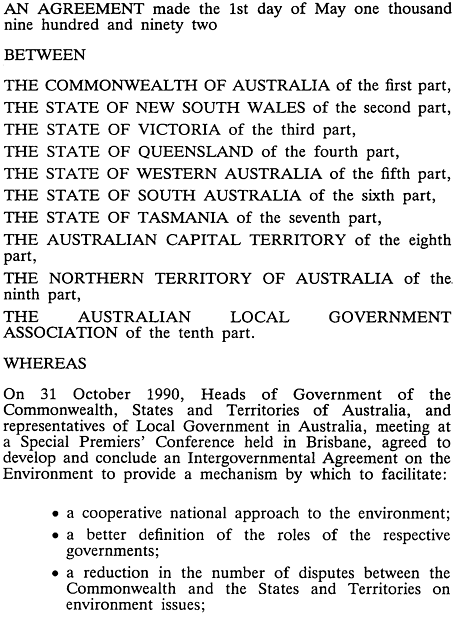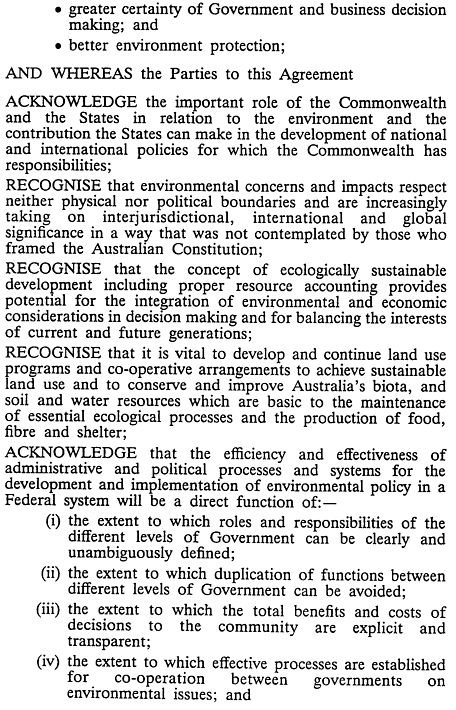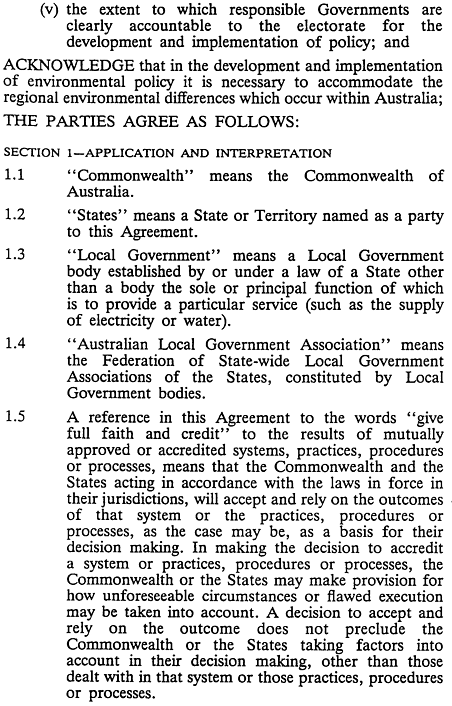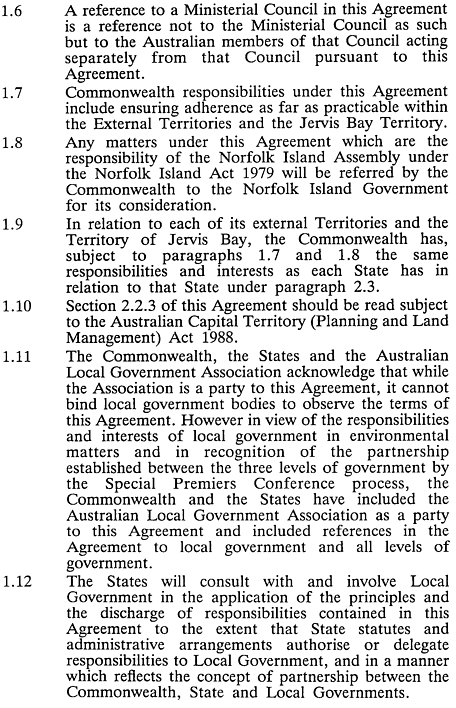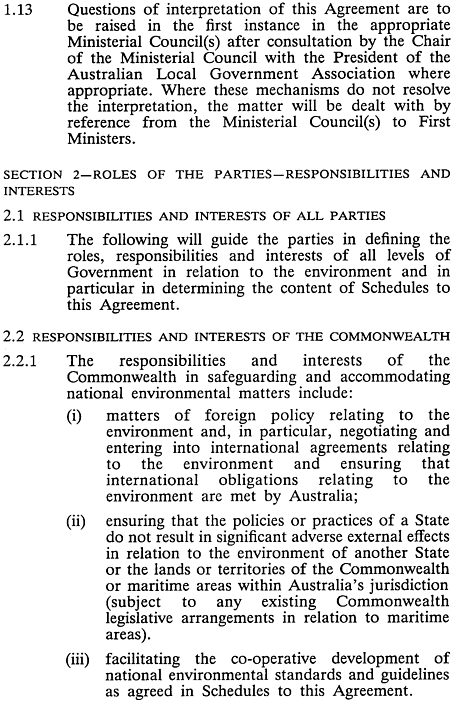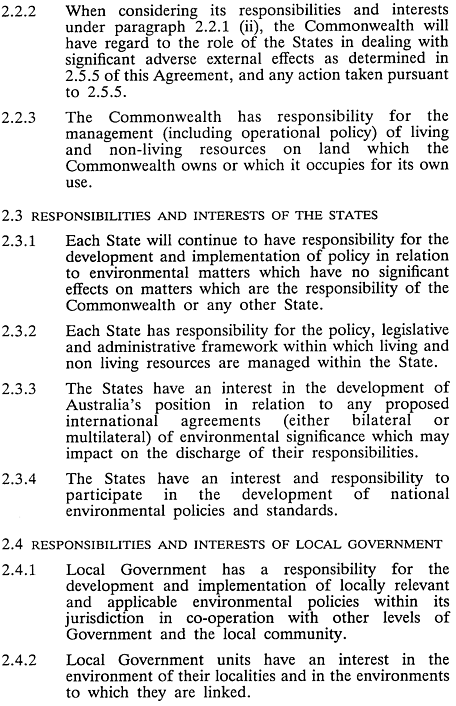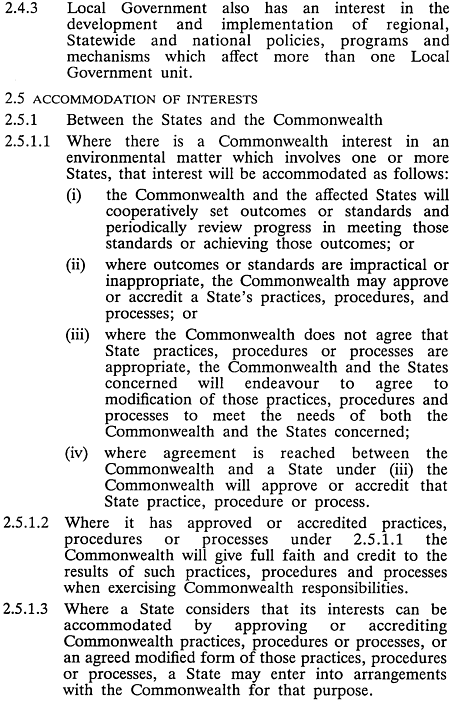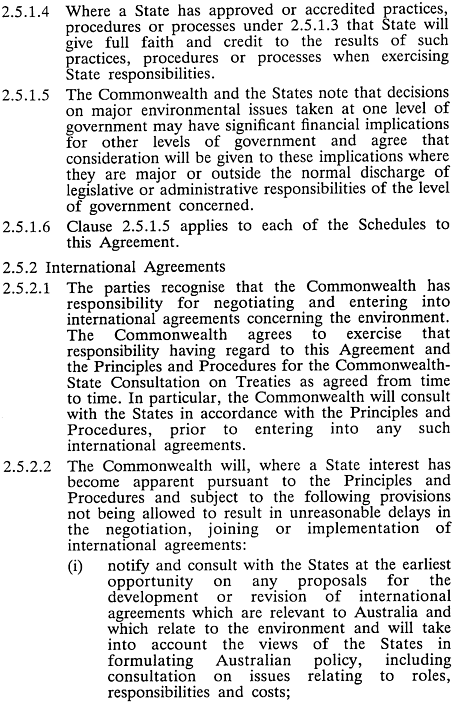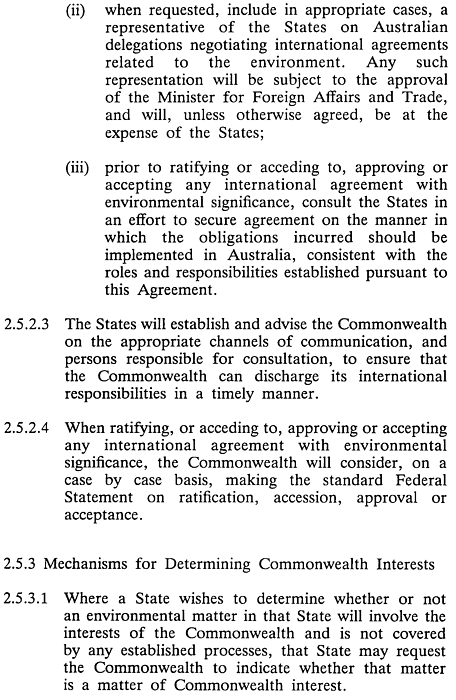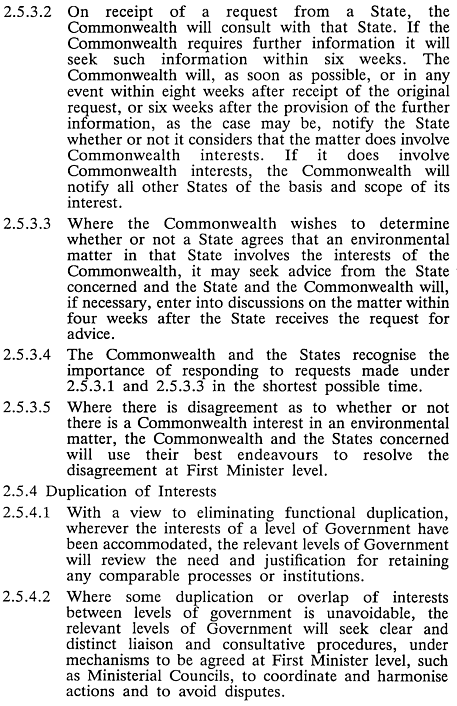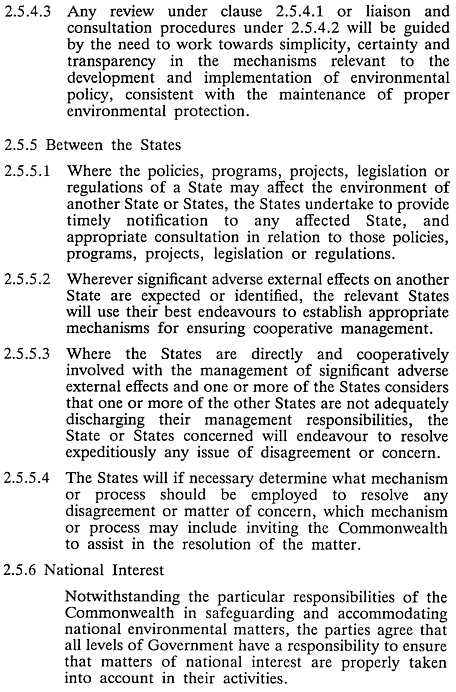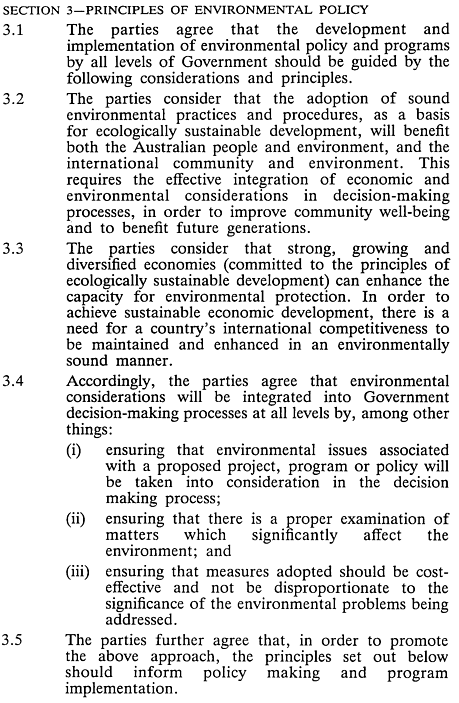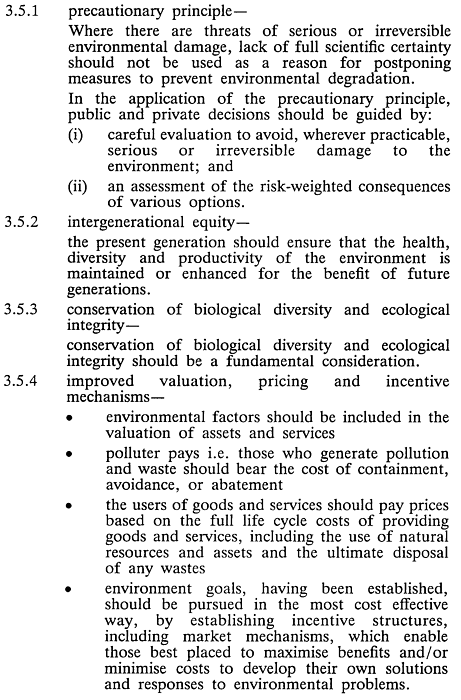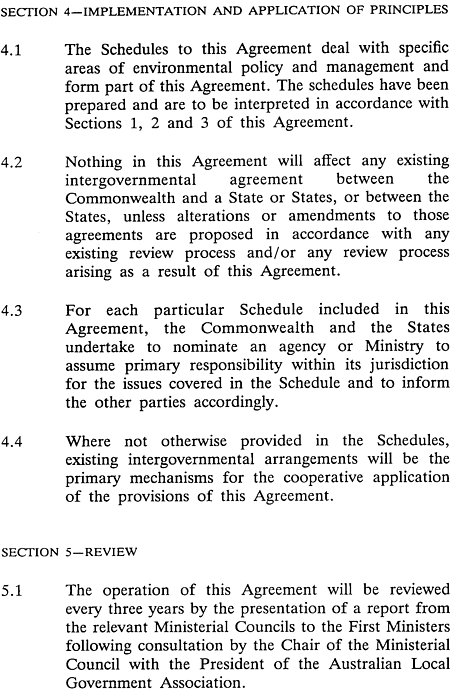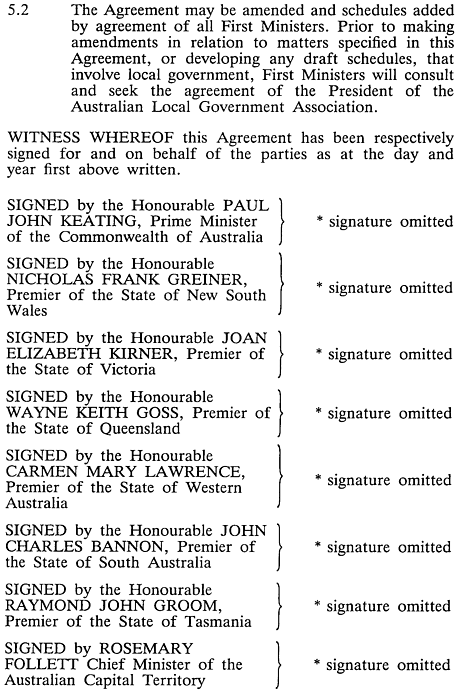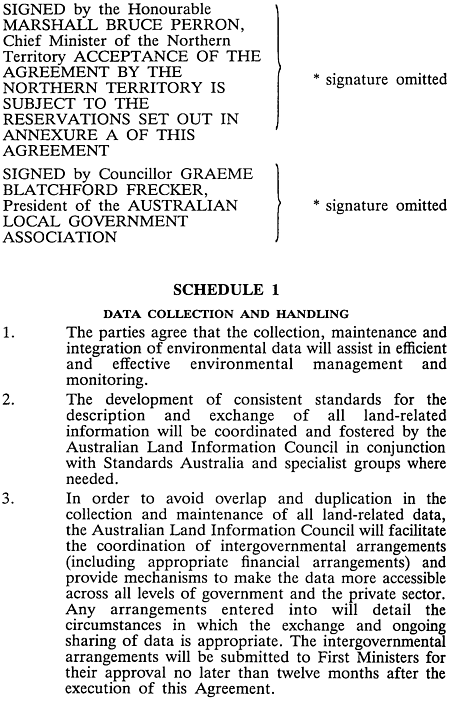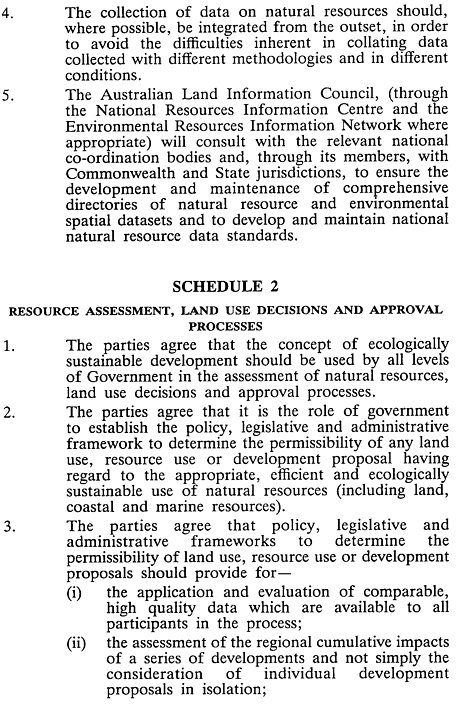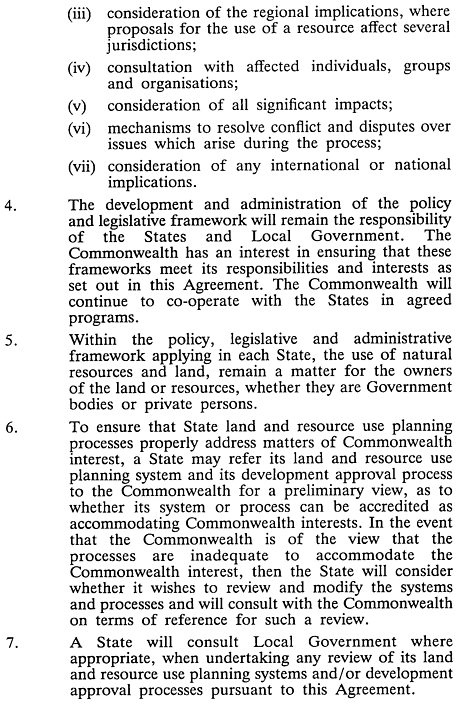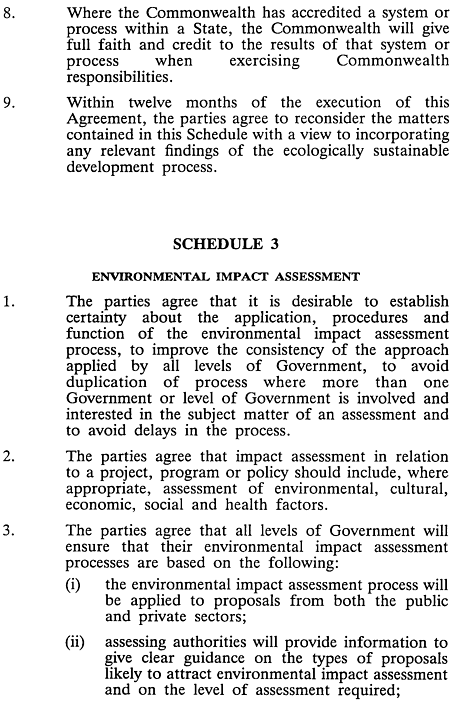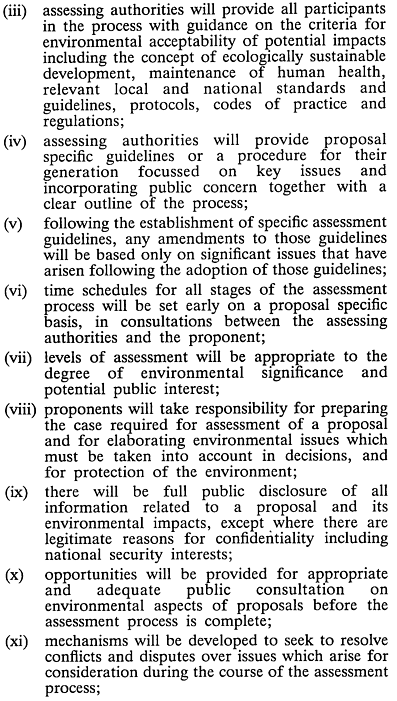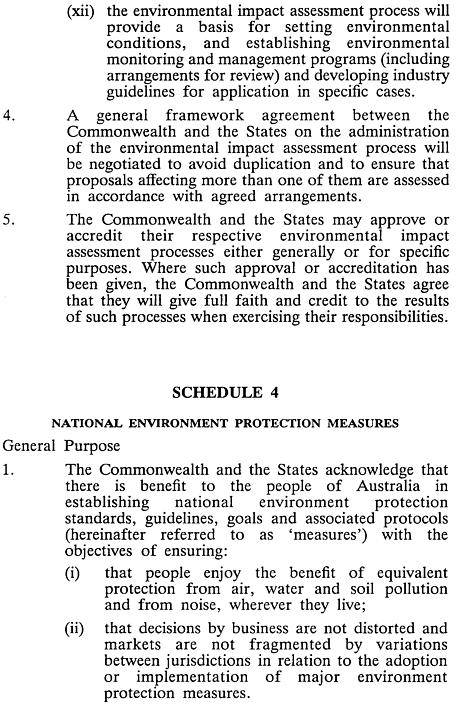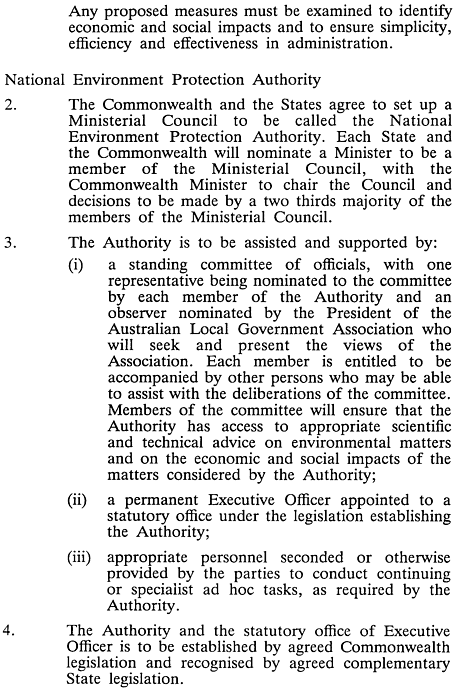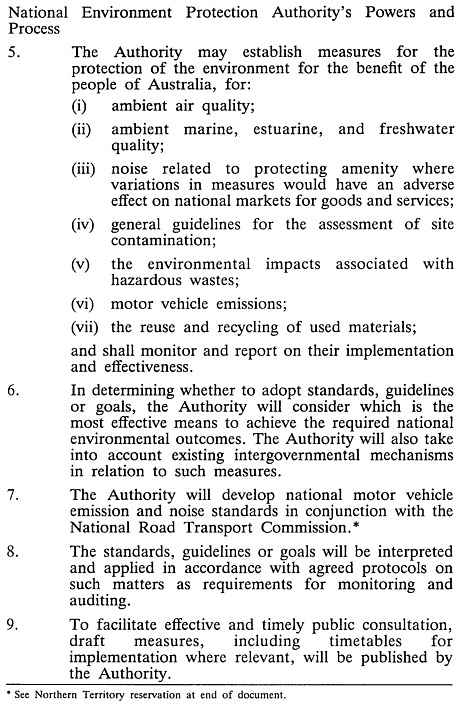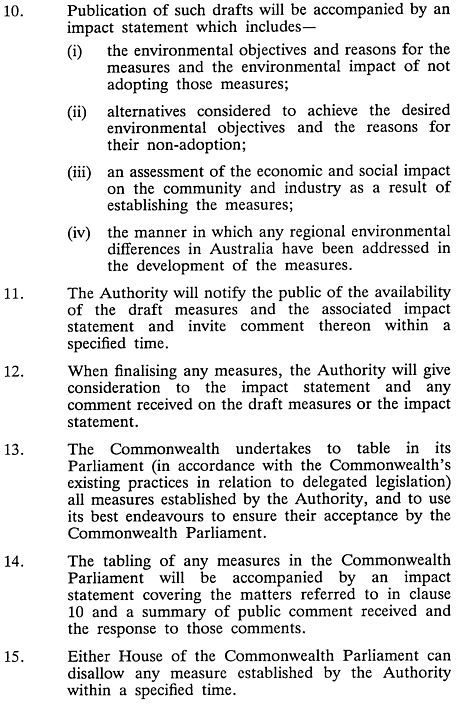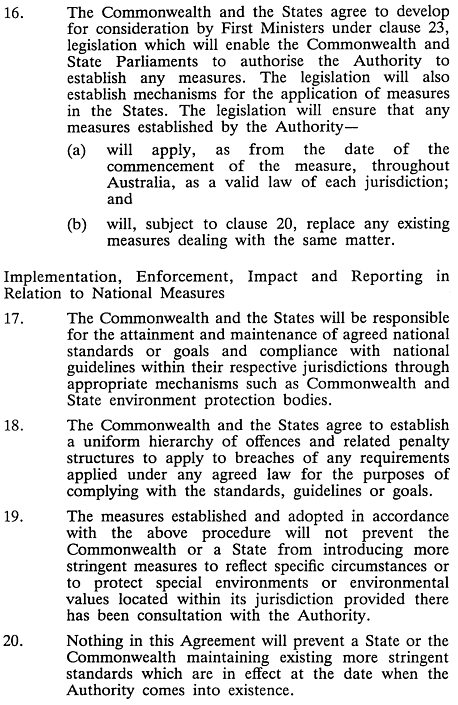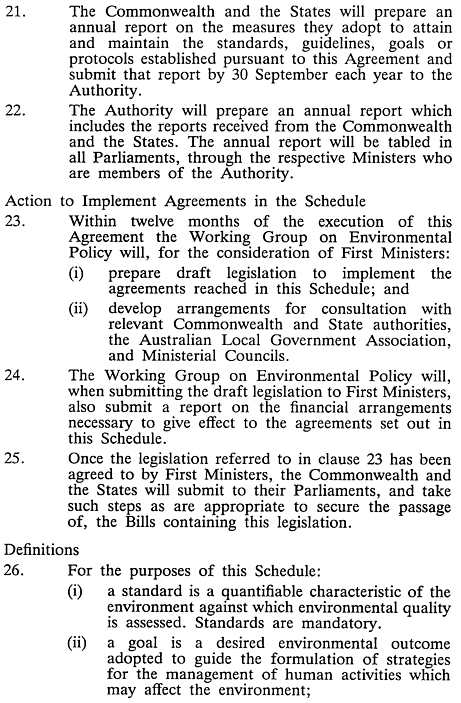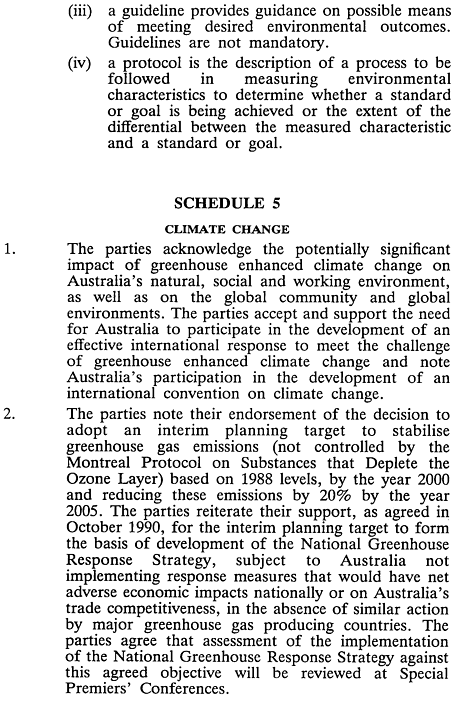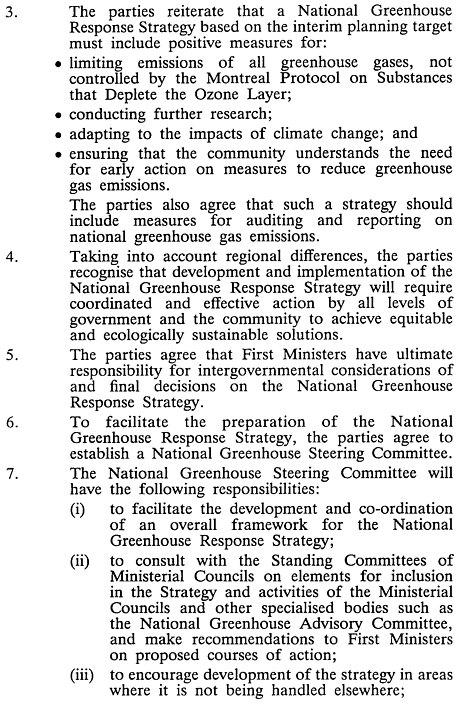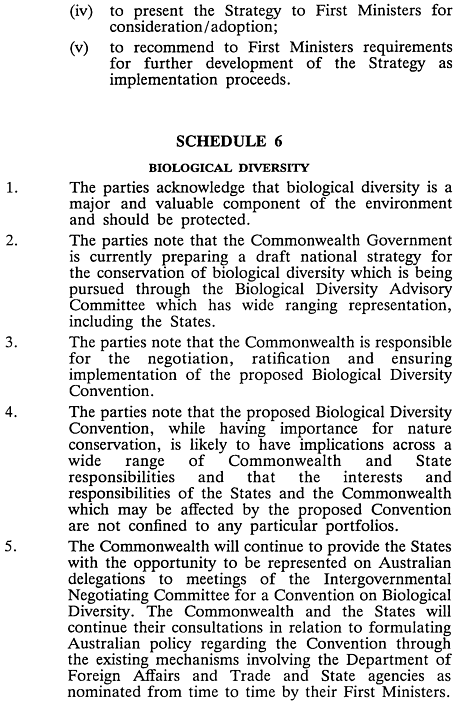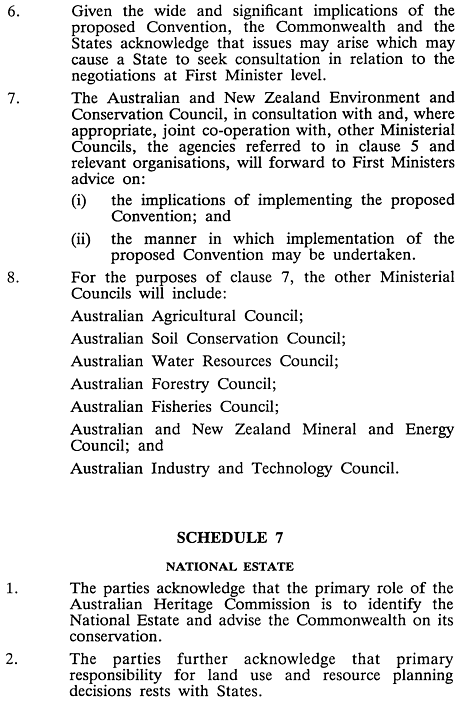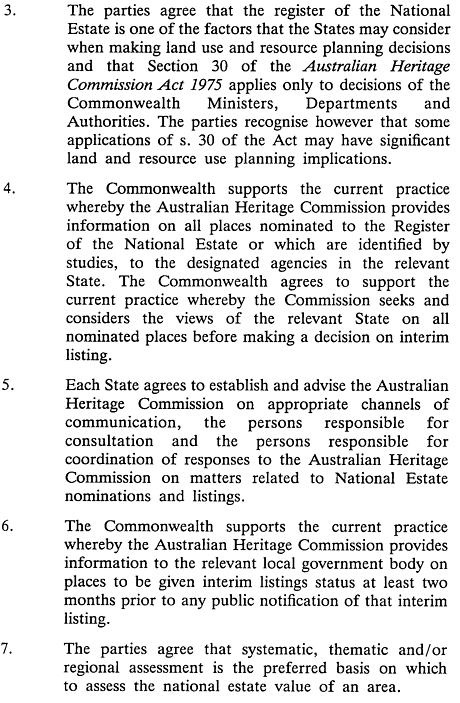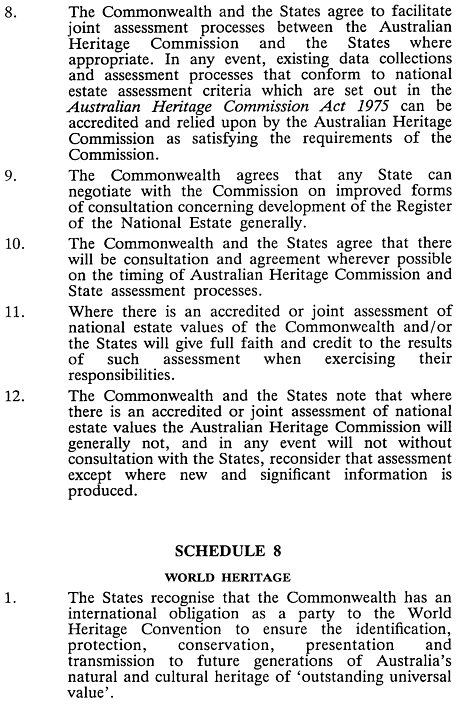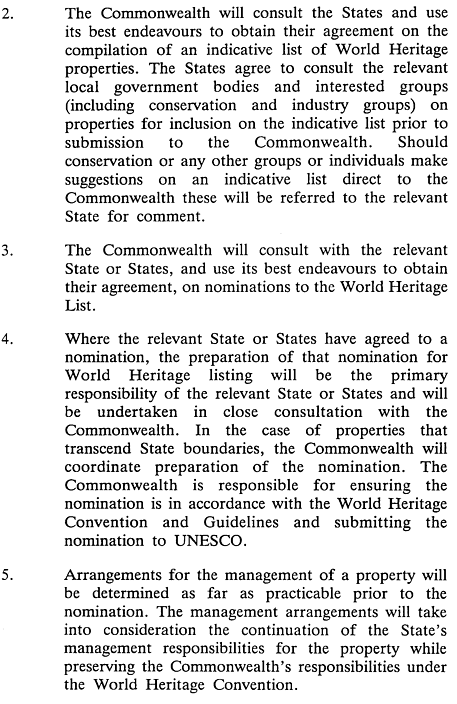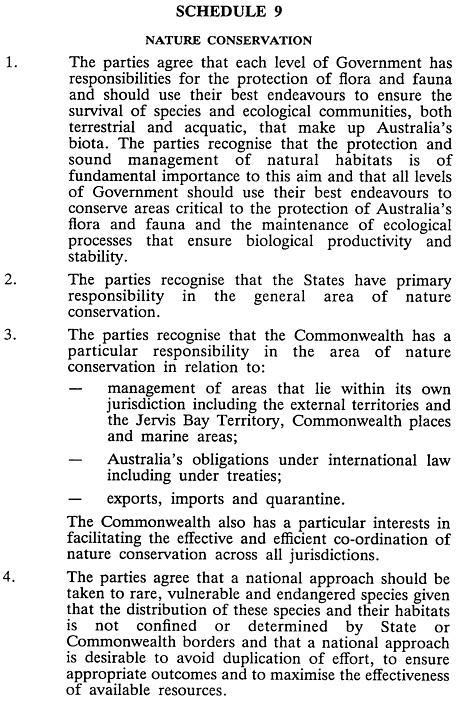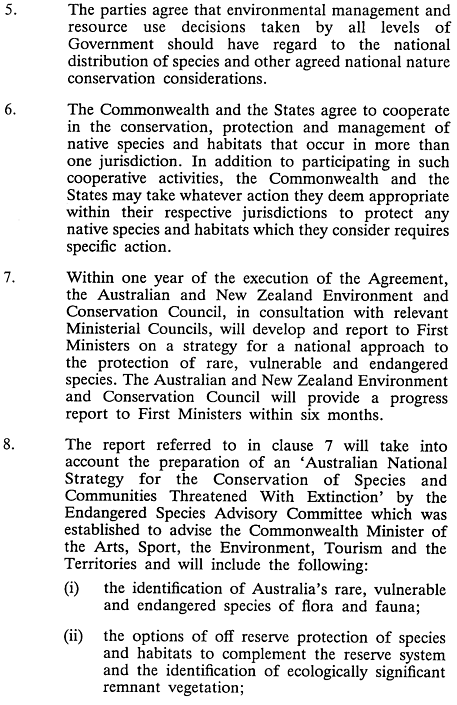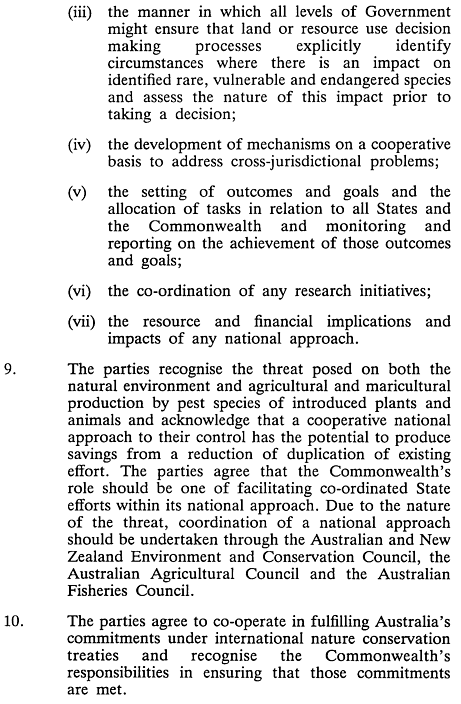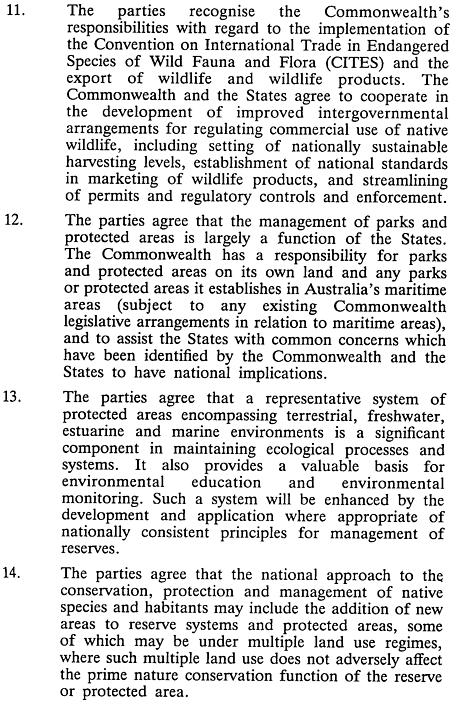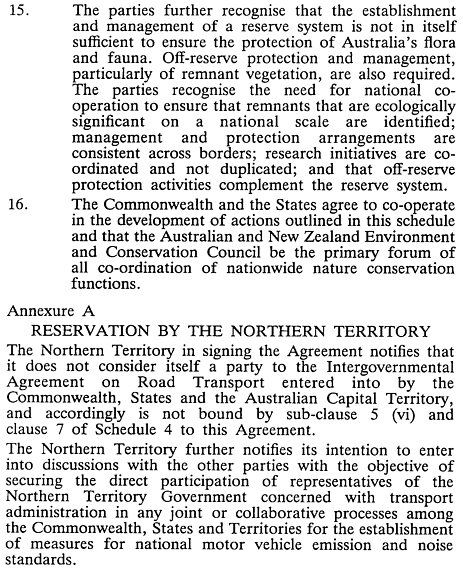National Environment Protection Council (Tasmania) Act 1995
An Act to provide for the establishment of a National Environment Protection Council and for related purposes
Whereas the Commonwealth, the States, the Australian Capital Territory, the Northern Territory and the Australian Local Government Association have entered into an Agreement known as the Intergovernmental Agreement on the Environment setting out certain responsibilities of each party in relation to the environment:
And whereas that Agreement provides that the Commonwealth, the States, the Australian Capital Territory and the Northern Territory will make joint legislative provision for the establishment of a body to determine national environment protection measures:
And whereas that Agreement further provides that once the form of the joint legislative provision for the establishment of the body has been agreed to, the Commonwealth, the States, the Australian Capital Territory and the Northern Territory will submit to their Parliaments or Legislative Assemblies, and take such steps as are appropriate to secure the passage of, Bills containing that legislation.
Be it therefore enacted by His Excellency the Governor of Tasmania, by and with the advice and consent of the Legislative Council and House of Assembly, in Parliament assembled, as follows:
PART 1 - Preliminary
This Act may be cited as the National Environment Protection Council (Tasmania) Act 1995 .
This Act commences on a day to be fixed by proclamation of the Governor notified in the Tasmanian Government Gazette.
The object of this Act is to ensure that, by means of the establishment and operation of the National Environment Protection Council –(a) people enjoy the benefit of equivalent protection from air, water or soil pollution and from noise, wherever they live in Australia; and(b) decisions of the business community are not distorted, and markets are not fragmented, by variations between participating jurisdictions in relation to the adoption or implementation of major environment protection measures.
This Act binds the Crown in right of Tasmania and, in so far as the legislative power of the Parliament of Tasmania permits, the Crown in all its other capacities.
5. Application of Acts of interpretation
(1) If an expression used in this Act or the regulations under this Act would (because of the Acts Interpretation Act 1931 ) have a different meaning from the meaning of the same expression used in the corresponding provision of the Commonwealth Act , the expression has the meaning it has in the Commonwealth Act , unless the contrary intention appears.(2) Accordingly, the Acts Interpretation Act 1931 does not apply to the interpretation of that expression.
(1) In this Act, unless the contrary intention appears –Agreement means the agreement made on 1 May 1992 between the Commonwealth, the States, the Australian Capital Territory, the Northern Territory and the Australian Local Government Association, a copy of which is set out in the Schedule ;Australian Local Government Association means the Australian Local Government Association Limited;Commonwealth Act means the National Environment Protection Council Act 1994 of the Commonwealth;Council means the National Environment Protection Council established by section 8 ;member means a member of the Council;[Section 6 Subsection (1) amended by No. 13 of 2003, s. 4, Applied:19 Dec 2003] Ministerial Council means a council, comprising one or more Ministers of the Commonwealth and Ministers of one or more States or Territories, that includes environmental protection in its functions;[Section 6 Subsection (1) amended by No. 13 of 2003, s. 4, Applied:19 Dec 2003] minor variation, in relation to a national environment protection measure, means a decision under section 22A(1) to vary a national environment protection measure;national environment protection goal means a goal –(a) that relates to desired environmental outcomes; and(b) that guides the formulation of strategies for the management of human activities that may affect the environment;national environment protection guideline means a guideline that gives guidance on possible means for achieving desired environmental outcomes;national environment protection measure means a measure made under section 14 (1) ;national environment protection protocol means a protocol that relates to the process to be followed in measuring environmental characteristics to determine –(a) whether a particular standard or goal is being met or achieved; or(b) the extent of the difference between the measured characteristic of the environment and a particular standard or a particular goal;national environment protection standard means a standard that consists of quantifiable characteristics of the environment against which environmental quality can be assessed;NEPC Committee means the committee established by section 29 ;NEPC Executive Officer means the person who, from time to time, holds the office of NEPC Executive Officer established by section 39 and includes a person acting in that office;NEPC Service Corporation means the Corporation referred to in section 35 ;participating jurisdiction means the Commonwealth, a participating State or a participating Territory;participating State means a State –(a) that is a party to the Agreement ; and(b) in which an Act that corresponds to this Act is in force in accordance with the Agreement ;participating Territory means a Territory –(a) that is a party to the Agreement ; and(b) in which an Act that corresponds to this Act is in force in accordance with the Agreement ;Service Corporation means the NEPC Service Corporation;Territory means the Australian Capital Territory or the Northern Territory.(2) A reference in this Act to the implementation of national environment protection measures includes a reference to the enforcement of the laws and other arrangements made for the purpose of implementing those measures.
7. Implementation of national environment protection measures
It is the intention of the Parliament of the State that the State will, in compliance with its obligations under the Agreement , implement, by such laws and other arrangements as are necessary, each national environment protection measure in respect of activities that are subject to State law (including activities of the State and its instrumentalities).
PART 2 - Establishment and Membership of the National Environment Protection Council
8. The National Environment Protection Council
The National Environment Protection Council is established.
(1) The Council consists of the following members:(a) a Minister of the Commonwealth who is nominated by the Prime Minister;(b) a Minister of each participating State who is nominated by the Premier of the State concerned;(c) a Minister of each participating Territory who is nominated by the Chief Minister of the Territory concerned.(2) A member ceases to be a member if –(a) the participating State or participating Territory in respect of which the member is nominated ceases to be a participating State or participating Territory; or(b) the member ceases to be a Minister; or(c) another Minister of the same jurisdiction is nominated in substitution for the member.(3) Nominations under this section must be in writing.(4) The performance of a function or the exercise of a power by the Council is not affected by a vacancy or vacancies in the membership of the Council.(5) Anything done by or in relation to a person purporting to act under a nomination under this section is not invalid merely because there was a defect or irregularity in connection with the nomination.
10. Chairperson of the Council
The member referred to in section 9 (1) (a) is the Chairperson of the Council.
(1) The Prime Minister, the Premier of a participating State or the Chief Minister of a participating Territory may nominate a Minister to be the deputy of the Minister nominated under section 9 .(2) In the event of the absence or unavailability of the Chairperson, or of another member, the Minister nominated as the deputy of the Chairperson or of that other member –(a) may act in the place of the Chairperson or of that other member; and(b) while so acting, has all the functions and powers of the Chairperson or of that other member.(3) Nominations under this section must be in writing.(4) Anything done by or in relation to a person purporting to act under a nomination under subsection (1) is not invalid merely because –(a) there was a defect or irregularity in connection with the nomination; or(b) the occasion to act had not arisen or had ceased.
PART 3 - Functions and Powers of the Council
Division 1 - Functions and powers
The Council has the following functions:(a) to make national environment protection measures in accordance with Division 2 ;(b) to assess and report on the implementation and effectiveness, in participating jurisdictions, of national environment protection measures.
The Council has power to do all things that are necessary or convenient to be done for or in connection with the performance of its functions, and, in particular, has power to –(a) consult with appropriate persons and bodies; and(b) obtain advice and assistance from the NEPC Committee or from another committee established by the Council under section 33 ; and(c) undertake or commission research; and(d) publish reports relating to the functions and powers of the Council; and(e) provide information to the public (including industry); and(f) consult with relevant Commonwealth, State and Territory bodies; and(g) [Section 13 Amended by No. 13 of 2003, s. 5, Applied:19 Dec 2003] consult with the Australian Local Government Association; and(h) [Section 13 Amended by No. 13 of 2003, s. 5, Applied:19 Dec 2003] direct the Service Corporation to provide assistance and support to other Ministerial Councils.
Division 2 - Making of national environment protection measures
14. Council may make national environment protection measures
(1) The Council may, by instrument in writing, make a measure, to be known as a national environment protection measure, that relates to any one or more of the following:(a) ambient air quality;(b) ambient marine, estuarine and fresh water quality;(c) the protection of amenity in relation to noise (but only if differences in environmental requirements relating to noise would have an adverse effect on national markets for goods and services);(d) general guidelines for the assessment of site contamination;(e) environmental impacts associated with hazardous wastes;(f) the re-use and recycling of used materials;(g) except as provided in subsection (2) , motor vehicle noise and emissions.(2) Noise and emission standards relating to the design, construction and technical characteristics of new and in-service motor vehicles may only –(a) be developed and agreed in conjunction with the National Road Transport Commission; and(b) be determined in accordance with the National Road Transport Commission Act 1991 of the Commonwealth and, where appropriate, the Motor Vehicle Standards Act 1989 of the Commonwealth.(3) National environment protection measures must each comprise one or more of the following:(a) a national environment protection standard;(b) a national environment protection goal;(c) a national environment protection guideline;(d) a national environment protection protocol.
15. General considerations in making national environment protection measures
In making any national environment protection measure, the Council must have regard to –(a) whether the measure is consistent with section 3 of the Agreement; and(b) the environmental, economic and social impact of the measure; and(c) the simplicity, efficiency and effectiveness of the administration of the measure; and(d) whether the most effective means of achieving the desired environmental outcomes of the measure is by means of a national environment protection standard, goal or guideline or any particular combination of them; and(e) the relationship of the measure to existing intergovernmental mechanisms; and(f) relevant international agreements to which Australia is a party; and(g) any regional environmental differences in Australia.
16. Council to give notice of intention to prepare a draft of proposed measure
(1) If the Council intends to make a national environment protection measure, the Council must publish a notice –(a) specifying the subject of the proposed measure; and(b) stating that the Council intends to prepare a draft of the proposed measure.(2) The notice must –(a) be published in the Commonwealth of Australia Gazette; and(b) so far as each participating State or Territory is concerned – also be published, on at least 2 days during the month when the Commonwealth of Australia Gazette notice is published, in a newspaper circulating in that State or Territory.
17. Council to prepare draft of proposed measure and impact statement
Before making any national environment protection measure and not earlier than 30 days after the day on which section 16 (2) (b) has been fully complied with in all participating jurisdictions, the Council must prepare –(a) a draft of the proposed measure; and(b) an impact statement relating to the proposed measure that includes the following:(i) the desired environmental outcomes;(ii) the reasons for the proposed measure and the environmental impact of not making the measure;(iii) a statement of the alternative methods of achieving the desired environmental outcomes and the reasons why those alternatives have not been adopted;(iv) an identification and assessment of the economic and social impact on the community (including industry) of making the proposed measure;(v) a statement of the manner in which any regional environmental differences in Australia have been addressed in the development of the proposed measure;(vi) the intended date for making the proposed measure;(vii) the timetable (if any) for the implementation of the proposed measure;(viii) the transitional arrangements (if any) in relation to the proposed measure.
(1) Before making a national environment protection measure, the Council must publish a notice –(a) stating how the draft of the proposed measure and the impact statement may be obtained; and(b) inviting submissions to the Council on the proposed measure, or on the impact statement, within a specified period.(2) A notice must –(a) be published in the Commonwealth of Australia Gazette; and(b) so far as each participating State or Territory is concerned – also be published, on at least 2 days during the month when the Commonwealth of Australia Gazette notice is published, in a newspaper circulating in that State or Territory.(3) The period specified in each notice under subsection (1) must end not less than 2 months after the day on which subsection (2) (b) has been fully complied with in all participating jurisdictions.
19. Council to have regard to impact statements and submissions
In making a national environment protection measure, the Council is to have regard, in addition to the matters referred to in section 15 , to –(a) the impact statement that relates to the measure; and(b) any submissions it receives that relate to the measure or to the impact statement; and(c) any advice from the NEPC Committee or from a committee established under section 33 .
20. Variation or revocation of measures
(1) The Council may vary or revoke any national environment protection measure.(2) If the Council intends to vary or revoke a national environment protection measure, the Council must publish a notice specifying the measure that the Council intends varying or revoking.(3) The notice must –(a) be published in the Commonwealth of Australia Gazette; and(b) so far as each participating State or Territory is concerned – also be published, on at least 2 days during the month when the Commonwealth of Australia Gazette notice is published, in a newspaper circulating in that State or Territory.(4) Sections 15 , 17 , 18 and 19 apply to a variation or revocation of a national environment protection measure as if –(a) a reference to making a national environment protection measure were a reference to a variation or revocation of a national environment protection measure, as the case may be; and(b) a reference to a national environment protection measure were a reference to the variation or revocation of such a measure, as the case may be; and(c) a reference to a proposed national environment protection measure were a reference to a proposed variation or proposed revocation of such a measure, as the case may be; and(d) the reference in section 17 to the day on which section 16 (2) (b) has been fully complied with in all participating jurisdictions were a reference to the day on which subsection (3) (b) of this section has been fully complied with in all participating jurisdictions.(5) [Section 20 Subsection (5) inserted by No. 13 of 2003, s. 6, Applied:19 Dec 2003] Subsections (2) , (3) and (4) do not apply to a minor variation of a national environment protection measure under Division 2A.
21. National environment protection measures to be Commonwealth disallowable instruments
(1) Section 21 of the Commonwealth Act applies to national environment protection measures made by the Council.(2) Any such measure ceases to have effect if it is disallowed by either House of the Parliament of the Commonwealth or if it otherwise ceases to have effect for the purposes of the Commonwealth Act .
22. Failure to comply with procedural requirements
If –the failure does not invalidate the measure so made.(a) the Council fails to comply with a particular procedural requirement of this Act in making a national environment protection measure; but(b) despite that failure the Council has substantially complied with the procedural requirements of this Act for making that measure –
Division 2A - Minor variation of national environment protection measures
22A. Minor variation of measures
[Section 22A of Part 3 Inserted by No. 13 of 2003, s. 7, Applied:19 Dec 2003](1) The Council may vary any national environment protection measure if –(a) the variation is supported by a unanimous resolution of all of the members; and(b) the resolution states that the variation does not involve a significant change in the effect of the national environment protection measure.(2) If the Council decides under subsection (1) to vary a national environment protection measure, the Council must prepare –(a) a draft of the proposed variation; and(b) a statement relating to the variation that explains –(i) the reasons for the proposed variation; and(ii) the nature and effect of the proposed variation; and(iii) the reasons why the Council is satisfied that the variation does not involve a significant change in the effect of the national environment protection measure.(3) A variation under this section is a minor variation.
22B. Public consultation for minor variation
[Section 22B of Part 3 Inserted by No. 13 of 2003, s. 7, Applied:19 Dec 2003](1) Before making a minor variation to a national environment protection measure, the Council must publish a notice –(a) stating how the draft of the proposed variation and the explanatory statement may be obtained; and(b) inviting submissions to the Council on the proposed variation, or on the explanatory statement, within a specified period.(2) A notice must –(a) be published in the Gazette; and(b) in each participating State or Territory concerned – also be published, on at least one day during the month when the Gazette notice is published, in a newspaper circulating in that State or Territory.(3) The period specified in each notice under subsection (1) must end not less than one month after the day on which subsection (2)(b) has been fully complied with in all participating jurisdictions.
22C. Council to have regard to submissions
[Section 22C of Part 3 Inserted by No. 13 of 2003, s. 7, Applied:19 Dec 2003] In making a minor variation to a national environment protection measure, the Council must have regard to –(a) any submissions it receives that relate to the proposed variation or the explanatory statement; and(b) whether the measure is consistent with section 3 of the Agreement; and(c) relevant international agreements to which Australia is a party; and(d) any regional environmental differences in Australia.
Division 3 - Assessment and reporting on implementation and effectiveness of measures
23. Report by Minister on implementation and effectiveness of measures
(1) The Minister of the State who is a member of the Council is, after each reporting year of the Council, to prepare a report on the implementation of national environment protection measures during that year by the State and the effectiveness of those measures.(2) A report under subsection (1) must be submitted to the Council by 30 September next following each reporting year.(3) In this section, reporting year means a year ending on 30 June.
(1) The Council must, as soon as practicable after 30 September in each year, prepare a report of its operations during the year ended on the preceding 30 June.(2) A report prepared under subsection (1) must include –(a) a copy of the report the Council receives under section 23 and copies of the reports for the year that it receives from the Commonwealth and other State and Territory Ministers under corresponding legislation; and(b) the Council's overall assessment of the implementation and effectiveness of national environment protection measures having regard to all of the reports referred to in paragraph (a) .(3) A copy of the report is to be laid before each House of the Parliament of the State within 7 sitting days of that House after the Council has formally adopted the report.
PART 4 - Meetings of the Council and Establishment and Meetings of its Committees
Division 1 - Meetings of Council
The Chairperson –(a) may, at any time, convene a meeting of the Council; and(b) must convene a meeting of the Council when requested to do so in writing signed by at least two-thirds of the members.
(1) The Chairperson is to preside at all meetings at which he or she is present.(2) If the Chairperson is not present at a meeting, the members present are to elect one of their number to preside.(3) The Council is to keep minutes of each meeting.(4) Subject to this Division, the Council may regulate the conduct of the proceedings at its meetings as it thinks fit.
At a meeting, two-thirds of the members constitute a quorum.
(1) At a meeting, a decision of the Council must be supported by the votes of at least two-thirds of the members, whether present or not.(2) The member presiding at a meeting of the Council has a deliberative vote only.
Division 2 - Committees of Council
(1) There is established by this section a committee known as the National Environment Protection Council Committee.(2) The NEPC Committee consists of the following members:(a) the NEPC Executive Officer;(b) a nominee of each member of the Council, being an official of the Commonwealth, a State or a Territory, as the case requires.(3) The President of the Australian Local Government Association may nominate a person who is entitled to attend and be heard at any meeting of the NEPC Committee but who is not entitled to vote at any such meeting.
30. Chairperson of NEPC Committee
The nominee of the Chairperson of the Council is to be Chairperson of the NEPC Committee.
31. Procedures of NEPC Committee
(1) Meetings of the NEPC Committee are to be convened at the request of the Council or by the Chairperson of the Committee in accordance with procedures determined by the Council.(2) The procedures to be followed at a meeting of the NEPC Committee are to be determined by the Committee.
32. Functions of NEPC Committee
The functions of the NEPC Committee are to assist and advise the Council in the performance of its functions and the exercise of its powers.
(1) The Council may establish other committees to assist the Council in developing national environment protection measures (including assistance on specified issues).(2) The functions, membership and procedures of such other committees are to be determined by the Council.
(1) If a State or Territory ceases to be a participating State or participating Territory –(a) the member of the NEPC Committee nominated by the Premier of the State or Chief Minister of the Territory ceases to be a member of the NEPC Committee; and(b) a member of any other committee who represents the State or Territory ceases to be a member of that other committee.(2) If the Australian Local Government Association ceases to be a party to the Agreement , the person nominated by the Association to attend and be heard at meetings of the NEPC Committee ceases to be entitled so to attend and be heard.
PART 5 - NEPC Service Corporation, NEPC Executive Officer and Staff
Division 1 - The NEPC Service Corporation
(1) The NEPC Service Corporation is the corporation with perpetual succession constituted by section 35 of the Commonwealth Act .(2) The Service Corporation –(a) may acquire, hold and dispose of real and personal property; and(b) may sue and be sued.(3) The seal of the Service Corporation is to be kept in such custody as the Council directs and is not to be used except in the circumstances authorised by the Council.(4) All courts, judges and persons acting judicially must –(a) take judicial notice of the imprint of the seal of the Service Corporation appearing on any document; and(b) presume the imprint was duly made.
36. Functions of the Service Corporation
The functions of the Service Corporation are –(a) to provide assistance and support to the Council, the NEPC Committee and any other committee established under section 33 ; and(ab) [Section 36 Amended by No. 13 of 2003, s. 8, Applied:19 Dec 2003] to provide assistance and support to other Ministerial Councils as directed by the Council;(b) [Section 36 Amended by No. 13 of 2003, s. 8, Applied:19 Dec 2003] to do anything incidental or conducive to the performance of the function referred to in paragraph (a) or paragraph (ab) .
37. Powers of the Service Corporation
(1) The Service Corporation has power to do all things that are necessary or convenient to be done for or in connection with the performance of the functions of the Corporation and, in particular, has power –(a) to enter into contracts; and(b) to lease the whole or any part of land or a building for the purposes of the Corporation; and(c) to occupy, use and control any land or building owned or held under lease by the State and made available for the purposes of the Corporation; and(d) to acquire, hold and dispose of personal property; and(e) to accept gifts, devises and bequests made to the Corporation, whether on trust or otherwise, and to act as trustee of money or other property vested in the Corporation on trust; and(f) to do anything incidental to any of the powers of the Corporation.(2) Despite anything contained in this Act, any money or property vested in the Corporation on trust must be dealt with in accordance with the powers and duties of the Corporation as trustee.(3) The Corporation has power to perform any of its functions in co-operation with the Commonwealth, a State or a Territory, with an authority of the Commonwealth or of a State or a Territory or with a local government body.
The Service Corporation must not, without the written approval of the Council –(a) enter into a contract involving the payment or receipt of an amount exceeding $250 000 or, if a higher amount is prescribed under section 38 of the Commonwealth Act , that higher amount; and(b) take any land or buildings on lease for a period exceeding 3 years.
Division 2 - The NEPC Executive Officer
(1) There is to be a NEPC Executive Officer.(2) The NEPC Executive Officer is to be appointed by the Council.(3) The NEPC Executive Officer is to be appointed for such period, not exceeding 5 years, as is specified in the instrument of appointment, but is eligible for re-appointment.
40. NEPC Executive Officer to control Service Corporation
(1) The affairs of the Service Corporation are, subject to section 41 , to be conducted by the NEPC Executive Officer.(2) All acts and things done in the name of, or on behalf of, the Service Corporation by or with the authority of the NEPC Executive Officer are taken to have been done by the Corporation.
41. NEPC Executive Officer to act in accordance with Council directions
(1) The Council may, by notice in writing given to the NEPC Executive Officer, give directions to the Executive Officer with respect to the conduct of the affairs of the Service Corporation.(2) The NEPC Executive Officer must comply with a direction given under subsection (1) .
42. Remuneration and allowances
(1) The NEPC Executive Officer is to be paid such remuneration as is determined by the Remuneration Tribunal of the Commonwealth in accordance with the law of the Commonwealth, but, if no determination of that remuneration is in force, is to be paid such remuneration as is determined in writing by the Council.(2) The NEPC Executive Officer is to be paid such allowances as are determined by the Council.(3) Remuneration and allowances payable to the NEPC Executive Officer under this section are to be paid out of the money of the Service Corporation referred to in section 55 .(4) This section, other than subsection (3) , has effect subject to the Remuneration Tribunal Act 1973 of the Commonwealth.
(1) Subject to section 87E of the Public Service Act 1922 of the Commonwealth, the NEPC Executive Officer has such recreation leave entitlements as are determined by the Remuneration Tribunal of the Commonwealth in accordance with the law of the Commonwealth.(2) The Council may grant the NEPC Executive Officer leave of absence other than recreation leave on such terms and conditions as to remuneration or otherwise as the Council determines.
The NEPC Executive Officer may resign his or her office by writing signed by him or her and delivered to the Chairperson of the Council.
(1) The Council may terminate the appointment of the NEPC Executive Officer because of misbehaviour or physical or mental incapacity.(2) If the NEPC Executive Officer –the Council must terminate his or her appointment.(a) engages in paid employment outside the duties of his or her office without the approval of the Council; or(b) is absent from duty, except on leave of absence, for 14 consecutive days or 28 days in any 12 months; or(c) becomes bankrupt or applies to take the benefit of any law for the relief of bankrupt or insolvent debtors, compounds with his or her creditors or makes an assignment of his or her remuneration for their benefit; or(d) contravenes section 41 (2) without reasonable excuse –
46. Terms and conditions not provided for by Act
The NEPC Executive Officer holds office on such terms and conditions (if any) in relation to matters not provided for by this Act as are determined by the Council from time to time.
47. Acting NEPC Executive Officer
The Council may appoint a person to act as the NEPC Executive Officer –(a) during a vacancy in the office of NEPC Executive Officer, whether or not an appointment has previously been made to the office; or(b) during any period, or during all periods, when the NEPC Executive Officer is absent from Australia or, for any reason, is unable to perform the functions of his or her office.
48. Powers and functions of acting NEPC Executive Officer
A person acting in the office of NEPC Executive Officer –(a) has, and may exercise, all the powers of the Executive Officer; and(b) may perform any of the functions of the Executive Officer; and(c) is to be taken to be the Executive Officer for the purpose of any reference to the Executive Officer in any other law.
Division 3 - Staff of the Service Corporation and consultants
49. Public Service staff of Service Corporation
(1) Subject to this Division, staff of the Service Corporation are to be persons appointed or employed under the Public Service Act 1992 of the Commonwealth.(2) The NEPC Executive Officer may exercise the powers conferred by section 49 (2) and (3) of the Commonwealth Act .
50. Non-Public Service staff of Service Corporation
(1) In addition to the staff referred to in section 49 (1) , the Service Corporation may employ persons, under written agreements, for the performance of any of the functions or the exercise of any of the powers of the Corporation.(2) The terms and conditions of employment of persons employed under subsection (1) are such as the Corporation determines from time to time.
51. Staff seconded to Service Corporation
(1) The Service Corporation may make arrangements for the services of officers and employees of Departments of the Australian Public Service, and of authorities of the Commonwealth, to be made available to the Corporation in connection with the performance of any of the functions or the exercise of any of the powers of the Corporation.(2) The Service Corporation may make arrangements with an officer or authority of a State or Territory under which the State or Territory or the authority makes officers or employees available to the Corporation to perform services in connection with the performance of any of the functions or the exercise of any of the powers of the Corporation.
(1) The Service Corporation may engage persons with suitable qualifications and experience as consultants.(2) The terms and conditions of engagement of consultants are such as the Corporation determines from time to time.
PART 6 - Finance
53. Payments to Service Corporation by State
(1) There is payable to the Service Corporation such money as is appropriated by the Parliament of the State for the purposes of the Corporation.(2) The Treasurer of the State may give directions about the amounts in which, and the times at which, money payable under subsection (1) is to be paid to the Corporation.
54. Payments to Service Corporation by Commonwealth and other States and Territories
The Service Corporation may receive money paid to it by the Commonwealth or by another State or Territory.
55. Money of Service Corporation
The money of the Service Corporation consists of –(a) money paid to the Corporation under section 53 ; and(b) money received by the Corporation under section 54 ; and(c) any other money paid to the Corporation.
56. Application of money of Service Corporation
The money of the Service Corporation is to be applied –(a) in payment or discharge of the costs, expenses and other obligations incurred by the Corporation in the performance of its functions and the exercise of its powers (including costs and expenses incurred by the Corporation on behalf of the Council or a committee of the Council); and(b) in payment of any remuneration or allowances payable under this Act; and(c) in providing, or paying for, any other benefits that are authorised under this Act.
(1) The NEPC Executive Officer is to prepare estimates, in such form as the Council directs, of the Service Corporation's receipts and expenditure for each financial year and, if the Council so directs, for any other period specified by the Council.(2) The Executive Officer must submit estimates so prepared to the Council not later than such date as the Council directs.(3) Except with the consent of the Council, the money of the Corporation must not be spent otherwise than in accordance with estimates of expenditure approved by the Council.(4) A direction, consent or approval for the purposes of this section is to be given by resolution of the Council carried in accordance with section 28 .
58. State audit, &c., legislation not to apply
[Section 58 Amended by No. 50 of 2008, Sched. 1, Applied:01 Mar 2009] [Section 58 Amended by No. 4 of 2017, Sched. 1, Applied:01 Jul 2019] Sections 13 , 14 , 15 , 16 , 50 , 51 , 56 , 57 , 58 and 59 and Parts 4 and 5 of the Financial Management Act 2016 and the Audit Act 2008 do not apply to the Service Corporation.
59. Special provisions relating to reports, &c., prepared under the Audit Act 1901 of the Commonwealth
(1) A report prepared by the Service Corporation under section 63M of the Audit Act 1901 of the Commonwealth must also contain such other information as is required by the Council to be included in the report.(2) A copy of each report and of each set of financial statements given to the Commonwealth Minister under section 63M of the Audit Act 1901 of the Commonwealth must also be given to each of the other members of the Council as soon as practicable after the end of the financial year to which they relate.
PART 7 - Miscellaneous
60. Powers and functions conferred under corresponding legislation
The Council, each committee of the Council, the NEPC Service Corporation and the NEPC Executive Officer have, in addition to the powers and functions conferred on them by this Act, such powers and functions as are conferred on them by the Act of each other participating jurisdiction that corresponds to this Act.
(1) The Council may, by resolution, delegate all or any of its functions and powers conferred by this Act (other than its powers under sections 14 , 20 and 63 ) to the NEPC Committee, the Service Corporation or the NEPC Executive Officer.(2) A delegation under this section may be varied or revoked by resolution of the Council (whether or not constituted by the persons constituting the Council at the time when the power or function was delegated).(3) Sections 23AA and 23A of the Acts Interpretation Act 1931 do not apply to a delegation by the Council.
(1) A certificate that –is, on mere production, receivable as prima facie evidence that the Council has done the act or thing or formed the opinion.(a) purports to be signed by a member of the Council or by the NEPC Executive Officer; and(b) states that the Council has done any act or thing or formed any opinion –(2) An act or thing done by the Council (whether by resolution, instrument or otherwise) does not cease to have effect merely because of a change in the Council's membership.
The Governor may, on the recommendation of the Council, make regulations for the purposes of this Act.
64. Review of operation of Act
(1) The Council must cause a review of –to be undertaken as soon as possible after the fifth anniversary of the commencement of that corresponding Act of the Commonwealth.(a) the operation of this Act and the Act of each other participating jurisdiction that corresponds to this Act; and(b) the extent to which the object set out in section 3 of each such Act has been achieved –(2) The report of the review is to be tabled in each House of Parliament of the State within 12 months after the fifth anniversary of that commencement.(3) [Section 64 Subsection (3) inserted by No. 13 of 2003, s. 9, Applied:19 Dec 2003] As soon as possible after the end of every 5 year period following the review under subsection (1) , the Council must cause a further review of the kind set out in that subsection to be undertaken.(4) [Section 64 Subsection (4) inserted by No. 13 of 2003, s. 9, Applied:19 Dec 2003] The report of each further review is to be tabled in each House of Parliament within 12 months after the end of the period to which it relates.
PART 8 - Amendment of State Policies and Projects Act 1993The amendment effected by this section has been incorporated into the authorised version of the State Policies and Projects Act 1993 .
PART 9 - Administration of Act
Until provision is made in relation to this Act by order under section 4 of the Administrative Arrangements Act 1990 –(a) the administration of this Act is assigned to the Minister for Environment and Land Management; and(b) the Department responsible to the Minister for Environment and Land Management in relation to the administration of this Act is the Department of Environment and Land Management.
SCHEDULE 1 - Intergovernmental Agreement on the Environment


